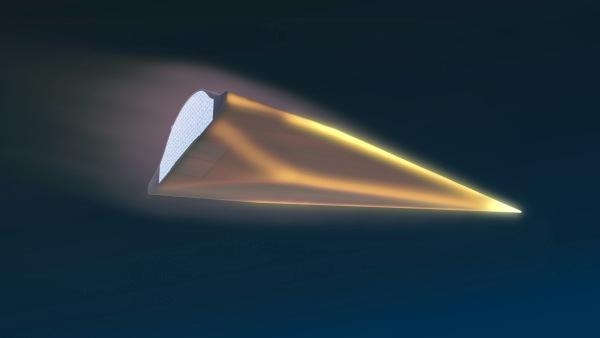Wed, Aug 24, 2011
Flight 1 Engineering Changes Believed Effective
During a test flight Thursday, 11 August, DARPA's Falcon HTV-2
scramjet powered aircraft experienced a flight anomaly post perigee
and into the vehicle's climb. The anomaly prompted the vehicle's
autonomous flight safety system to use the craft's aerodynamic
systems to make a controlled descent and splash down into the
ocean, according to a DARPA news release. Controlled descent is a
term typically associated with a human-in-the-loop directing or
guiding the unscheduled landing of an aircraft. For DARPA's
Hypersonic Technology Vehicle 2 (HTV-2) controlled descent takes on
new meaning thanks to the vehicle's safety system.

"We've confirmed that the HTV-2 made impact with the Pacific
Ocean along its flight trajectory as planned in the event of an
anomaly," explained Air Force Maj. Chris Schulz, DARPA HTV-2
program manager and PhD in aerospace engineering. "This flight
safety system is a significant engineering advance in that the
system prompts a vehicle to monitor the parameters under which it
is operating and exercise safety protocols completely autonomously
should those parameters be breached."
"According to a preliminary review of the data collected prior
to the anomaly encountered by the HTV-2 during its second test
flight," said DARPA Director Regina Dugan, "HTV-2 demonstrated
stable aerodynamically controlled Mach 20 hypersonic flight for
approximately three minutes. It appears that the engineering
changes put into place following the vehicle's first flight test in
April 2010 were effective. We do not yet know the cause of the
anomaly for Flight 2."
A detailed analysis conducted by an independent Engineering
Review Board following the first flight test, prompted engineers to
adjust the vehicle's center of gravity, decrease the angle of
attack flown and use the onboard reaction control systems to
augment vehicle flaps during the vehicle's second flight test.
Those changes appear to have been effective. "An initial assessment
indicates," said Schulz, "that the Flight 2 anomaly is unrelated to
the Flight 1 anomaly."
More News
Aero Linx: Model Aeronautical Association of Australia MAAA clubs are about fun flying, camaraderie and community. For over 75 years, the MAAA has been Australia’s largest fl>[...]
Touchdown Zone Lighting Two rows of transverse light bars located symmetrically about the runway centerline normally at 100 foot intervals. The basic system extends 3,000 feet alon>[...]
“Discovery and innovation are central to our mission at Virgin Galactic. We’re excited to build on our successful record of facilitating scientific experiments in subor>[...]
How To Get A Story On Aero-TV News/Feature Programming How do I submit a story idea or lead to Aero-TV? If you would like to submit a story idea or lead, please contact Jim Campbel>[...]
Student Pilot Reported That During Rotation, “All Of A Sudden The Back Of The Plane Kicked To The Right..." Analysis: The student pilot reported that during rotation, “>[...]
 ANN's Daily Aero-Linx (05.02.24)
ANN's Daily Aero-Linx (05.02.24) ANN's Daily Aero-Term (05.02.24): Touchdown Zone Lighting
ANN's Daily Aero-Term (05.02.24): Touchdown Zone Lighting Aero-News: Quote of the Day (05.02.24)
Aero-News: Quote of the Day (05.02.24) ANN FAQ: Contributing To Aero-TV
ANN FAQ: Contributing To Aero-TV NTSB Final Report: Cirrus Design Corp SR20
NTSB Final Report: Cirrus Design Corp SR20



